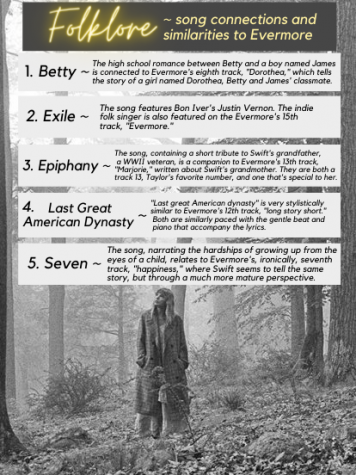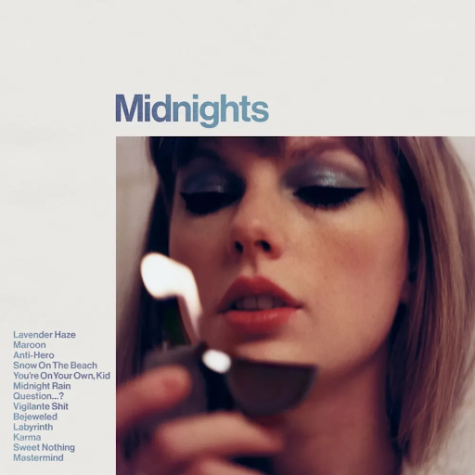The Swift sisters: Folklore and Evermore showcase Taylor Swift’s lyrical and musical growth
★★★★★
Only five months after releasing “Folklore,” Taylor Swift dropped a sequel album, “Evermore,” a collection of 15 songs and two bonus tracks. The album, along with “Folklore,” showcases yet another music style from Swift. Her past albums have been both country and pop albums, while “Evermore” fits more into the genre of alternative or indie. Being the “sister album,” to “Folklore,” “Evermore” continues the stories that Swift had begun to tell in the previous album.
The album’s debut track, “Willow,” quickly climbed its way to the number one spot on the Billboard charts. The love song describes the beginnings of falling in love, and the passion and complexity of wanting someone. The lyrics, “I’m begging for you to take my hand. Wreck my plans, that’s my man,” portray this desire.
Swift tells stories through her music. Many of her songs tell tales through other perspectives than her own. The second track of the album, “Champagne problems,” tells the story of a relationship: the man with plans for marriage, while the woman has plans to end it. The song is sung from the perspective of the woman turning down the proposal, then later realizing what a prominent role that partner had in her life.
Characters play a large role in Swift’s storytelling. “Evermore” introduces us to many more of Swift’s characters, as we meet Marjorie, Dorothea and more. In the album’s fourth track, we are introduced to Dorothea: an actress who returns to her hometown and rekindles a relationship with her old flame. We are able to hear the male perspective of this tale in “Dorothea,” in which we hear him longing for her to end their separation from one another.
Swift did not fail to continue her moniker as a lyrical genius with “Evermore.” Each lyric evokes a profound feeling, and not only portrays her emotions as the writer, but also creates emotion in the audience. The fifth track of any Swift album will always be a heart-wrenching exposure. In “Evermore,” we hear “Tolerate It” as the fifth track. The song includes lyrics like, “While you were out building other worlds, where was I?” and “Now I’m begging for footnotes in the story of your life.” These lines portray the growing distance between a woman and her partner, showing him moving on and creating a life without her.
In the album’s 14th track, “Closure,” we hear the line, “I know I’m just a wrinkle in your new life.” The song tells the story of a woman who is repeatedly offered closure in her past relationship, but continuously rejects that opportunity. These lyrics portray the idea that while her partner may still play such a big role in her life, she is only a “wrinkle” in his life. Similar to the lyrics of “tolerate it,” Swift describes the concept of moving on, and how it is often very one-sided.
Stringed instruments are a big part of the composition of Swift’s songs. While “Evermore” falls into the indie and alternative rock category, guitar, smooth piano and gentle strings accompany the album’s slower pace. In the last track of the album, “Evermore,” featuring Bon Iver, we hear a soft piano through the entire song, and at some moments very faint strings. In “gold rush,” one of the faster paced songs in the album, we again hear a collection of strings accompanied by a basic beat. The soft strings and rhythms of “Evermore” connect with those of “Folklore.”
Swift’s ninth studio album as a whole contains powerful stories, characters, melodies, lyrics and more. Each of the 15 tracks deepen and complement the “sister album,” and continue the tales begun in the first of the two albums. Swift further proved her capabilities with “Evermore,” debuting a new style of music compared to her previous albums and showcasing her wide range of talents and creating an incredible listening experience.
















